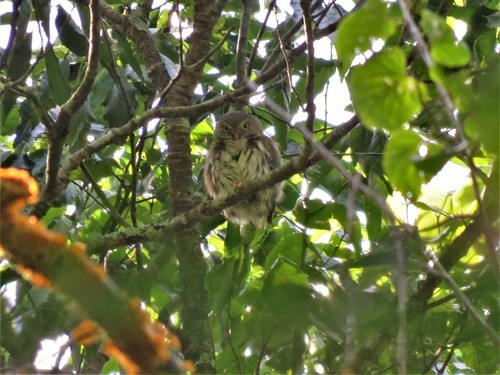Tamaulipas Pygmy-owl
A species of Pygmy-owls Scientific name : Glaucidium sanchezi Genus : Pygmy-owls
Tamaulipas Pygmy-owl, A species of Pygmy-owls
Botanical name: Glaucidium sanchezi
Genus: Pygmy-owls
Content
Description General Info
Description
The adult Tamaulipas pygmy owl has a length of between 13 and 16 cm (5.1 and 6.3 in) with a relatively long tail of between 5.1 and 5.7 cm (2.0 and 2.2 in). Their average weight is 53 grams (1.9 oz), the male generally being lighter than the female. The male has a brownish facial disc flecked with white with short white eyebrows. The upper parts are olive-brown, with a greyer crown and fine white speckling at the front and sides of the crown. The main wing and tail feathers are barred with white. The underparts are whitish with some reddish-brown streaking and mottling. The legs are feathered, the bill is yellowish-brown and the eyes yellow. The female is similar but has an overall more reddish-brown appearance. 
Size
13 - 23 cm
Nest Placement
Cavity
Feeding Habits
Tamaulipas Pygmy-owl primarily consumes insects and lizards, using stealth and agility while hunting. Unique adaptations for catching prey include acute hearing and night vision.
Habitat
The tamaulipas Pygmy-owl is predominantly found within subtropical, humid montane environments, including evergreen and semi-decidous forest regions as well as pine-evergreen forests, with a strong affinity for cloudforest habitats. This species typically resides at elevations ranging from 900 to 2100 meters, thriving in ecosystems that offer a damp climate and a rich assembly of montane flora.
Dite type
Carnivorous
General Info
Feeding Habits
Bird food type
Distribution Area
The Tamaulipas pygmy owl is endemic to Mexico where it is only found in the mountains of northeastern Mexico, in the northern part of the state of Hidalgo and the southeastern part of the state of San Luis Potosí. Its habitat is moist evergreen forest, montane forest and cloud forest at altitudes between about 900 and 2,100 m (3,000 and 6,900 ft). 
Species Status
At one time the International Union for Conservation of Nature rated the conservation status of the Tamaulipas pygmy owl as "least concern" but this has now been changed to "near-threatened". The forests in which this owl lives are being logged and the bird's range is now thought to be smaller than it was in the past. The population is also thought to be declining and is estimated to be fewer than 50,000 birds. 
Scientific Classification
Phylum
Chordates Class
Birds Order
Owls Family
True owls Genus
Pygmy-owls Species
Tamaulipas Pygmy-owl 